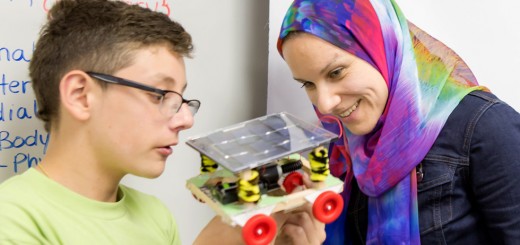Spartan Women in Sport: Marti Malloy, ’10 BS, ’15 MS Mass Communications

Photo: David Schmitz
On July 30, 2012, American judoka Marti Malloy faced Italian fighter Giulia Quintavalle on the Olympic mat in London. Polished and poised in her blue judo gi, Malloy circled her opponent, her footwork fast, precise, practiced. In the seconds before she caught Quintavalle by the ankle, pinning her to the floor with both arms, her body appeared calm, quiet. It wasn’t until Quintavalle was on the floor and the referee called the match, inspiring a cheer from the crowd, that the audience could see the recognition on Malloy’s face: She did it. She won, becoming only the second American woman to earn an Olympic medal in judo—in two and a half minutes.
Malloy,’10 Advertising, ’15 MS Mass Communications, ran from the orange mat to the sidelines, stopping to bow twice and shake her opponent’s hand before hugging her coach, Jimmy Pedro. She says that memory pushed her forward beyond the Olympics, driving her training while completing graduate school. In the years since that landmark moment, Malloy became the 2015 Pan American Games champion, qualified for the 2016 Olympics in Rio, and won the 2017 Grand Prix in Cancun.
Malloy has been a professional judoka for 15 years—half her life. These are the stories that Malloy has shared with her fans and the judo fighters she has helped coach. But what exactly does it take for a young woman to become an international judo champion—and what has kept her motivated?
“Who’s to say a girl is supposed to be feminine?”
Growing up on Whidbey Island in Washington, Malloy spent her weekends at the judo club while her peers were having sleepovers and pool parties. At 5’3 1/2″, she competed in the 57 kg category. So much of mastering the art of judo, she says, is to train your body and mind to react on impulse, and to make that reaction as effective and energy-efficient as possible. This means understanding your own strength—and trusting your body to react on instinct.
“You’re building a neural pathway in your brain so that you don’t need any thought to execute a move,” says Malloy. “What’s going through my mind in a judo fight? Nothing. You have to let your instincts and your training kick in.”
The greatest reward, she says, is when her body outsmarts her mind, and all the hours spent practicing pay off with a magnificent, well-timed throw.
“In London, I won in the middle point of the match,” she says. “The throw that I threw her with is one I do every single day. I saw the opportunity and I did it without thinking. That’s why it is so exciting. That’s what every judo player lives for—like a knockout in boxing, a hole in one in golf. That execution, without thought, for a full point, which automatically wins, we say ippon, is what we live for. Sometimes I’ll get a hint of that feeling when I win something—if I’m bowling and I get a strike, that’s similar—that’s a dash of salt compared to dousing something in hot sauce.”
As a professional woman athlete, Malloy confronted—and often defied—common stereotypes about gender and sport.
“People see me and say, ‘oh my gosh, you do judo? You’re so small’ or ‘you’re a girl,'” she says. “They automatically assume that because I do a martial art that involves throwing people to the floor and sometimes doing arm bars, that it can’t be something that I can do. I totally abhor that perception—that being a girl means you can’t do those kinds of things. Yeah, it’s not typical of femininity, but who’s to say a girl is supposed to be feminine?”
She doesn’t need to look far to find a role model whose career in sports has often challenged existing social norms. Attracted to San Jose State by its world-renowned judo program, spearheaded by legendary coach Yoshihiro Uchida, ’47 Biological Science, ’04 Honorary Doctorate, Malloy was admitted in spring 2005. Though at 19 she had already traveled worldwide, the transition to college presented other challenges—like paying for rent. Her freshman year, she worked 30 hours a week at a sandwich shop in downtown San Jose while juggling a full course load and 16 to 20 hours of judo training a week. Difficult as it was to balance, Malloy says she gained valuable perspective from Coach Uchida.
“Most people don’t know that SJSU’s Uchida Hall is dedicated to the memory of those who were sent to internment camps and got processed here, including Mr. Uchida’s family,” she says. “Seeing the struggle they went through and knowing his story is super humbling for me. The men that were on his team when he started the program back in the ’60s were six-foot-tall military recruits and police officers. They were bigger than him and they didn’t like the idea that a Japanese man was going to teach them anything. I see how he struggled through that and what that must have been like, to feel that animosity and hate for you, even though they know nothing about you. Anything I go through can’t even compare to that.”
When she decided to join the ranks at SJSU, the judo program had 10 woman athletes—but by the time she enrolled, their numbers dwindled. Unfazed, Malloy often practiced by fighting both men and women. She acknowledges that while some male athletes might be physically stronger, half the fun of judo is developing a level of skill to outperform one’s opponent.
As Uchida said of Malloy in a 2012 San Jose Mercury News article leading up to the London Olympics, “everybody respects her. She puts them in their place.” Uchida was at her side in London and again in Rio, when he was 96 years old. Only an inch shorter than her mentor, Malloy’s respect and admiration for Uchida are underscored by the sport’s core values, which are reinforced in every practice and at every competition. Fighters bow to each other before a match as a sign of respect, and the sport emphasizes “the gentle way,” a thoughtful manipulation of energy.
Occasionally, Malloy would encounter male counterparts who underestimated her. Supported by Uchida and Assistant Coach Mike Swain, ’85 Business, the first American world champion, four-time Olympian and Olympic bronze medalist, she was unafraid to challenge assumptions about her gender, strength or size.
“When I train with men, they might be the same size as me, but they are going to be physically stronger,” she says. “So I have to make my judo smarter. It has to be more technically savvy to catch them—I have to evade being overpowered. I’ve run into my fair share of guys who are intimidated or their ego or pride is injured because my skill is higher. I may be able to out-play them and beat them in a fight. If I were a guy, they wouldn’t care. I try to make them madder by beating them even more. They should learn that it doesn’t matter that I’m a woman—it’s the fact that I’m better prepared because I’ve trained harder and longer.”
Since retiring from competition in August 2017, Malloy has traveled the world teaching judo seminars. Though she will always be connected to the judo community, she is ready to establish roots and apply what she’s learned to the world at large. As the social media manager for MyHealthTeams, a startup that serves people living with chronic conditions, she manages 58 social media profiles, representing 28 conditions on two platforms. In other words, the Olympic judoka is still strong, adaptable, strategic—and giving back to a community larger than herself.
“At this point, with more of my judo career behind me than in front of me, I can say that I didn’t sacrifice—I won,” she says. “I used to think I sacrificed, but now I think I gained. I was learning how to be a disciplined, trained professional. I know about the world, and there’s no substitute for that.”



